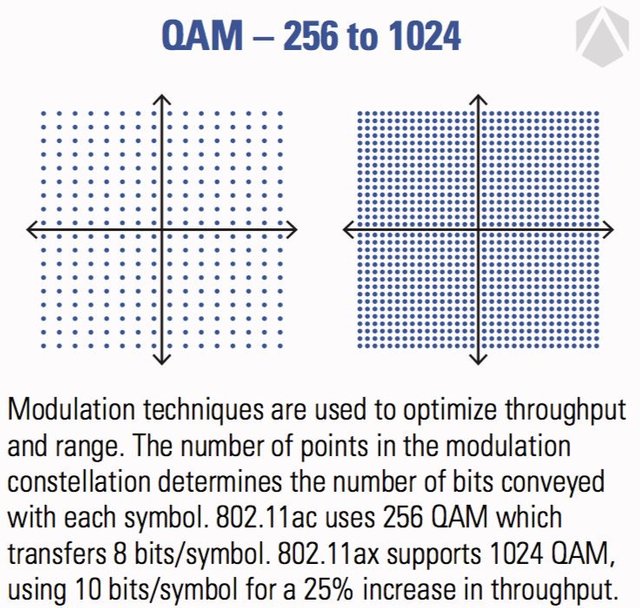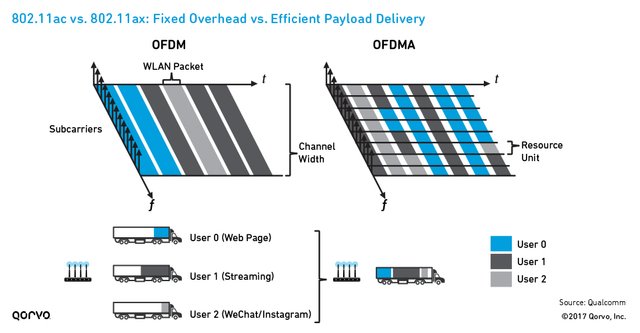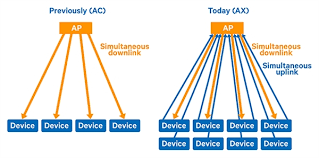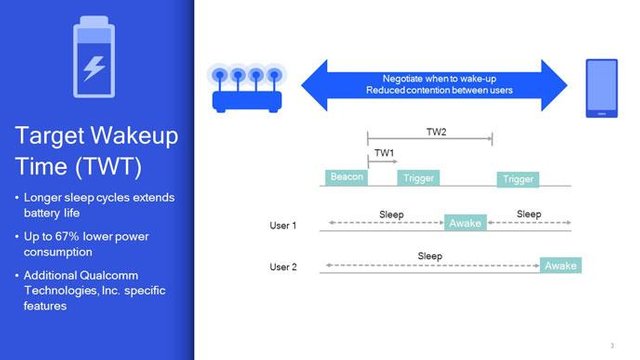Faster and More Efficient WiFi is Coming with 802.11ax
It's time for a new wireless standard to hit the street, and that rendition is 802.11ax. We should see full ratifictaion frow the IEEE sometime in 2019, but WiFi chipset manufacturers such as Broadcom, Qualcomm, Intel, and Quantenna are already manufacuring 802.11ax silicon based on Draft 1.0 of the 802.11ax standard. In addition, Asus and Aerohive have announced a 802.11ax router and family of enterprise access points respectively. But why do we need a new standard, and how will 802.11ax deliver performance improvements on WiFi networks?
Why do we need a new standard? Didn't 802.11ac Wave 2 just come out, and isn't that good enough?
The main goals of 802.11n, 802.11ac Wave 1, and 802.11ac Wave 2 were to increase overall throughput over the wireless medium. These were important adancements in WiFi, but as device density has grown, not much has been done to increase capacity on wireless networks. So while there is more bandwidth available, we are still not very efficient at using the RF spectrum and we see performance suffer on high density WiFi networks. This is a major issue, because device density is currently exploding. I don't know about you, but in my home in just a few short years, we have gone from just a couple laptops and cell phones to a much more connected home. We now have several laptops, phones, tablets, watches, thermostats, door locks, speakers, and the list goes on. All of these devices are competing to access the wireless network, and the list of connected devices is going to keep growing at a rapid rate as more and more IoT devices come online. 802.11ac Wave 2 tried to address some of these density issues by introducing MU-MIMO, but the MU-MIMO implementation in 802.11ac Wave 2 only supports MU-MIMO on the downlink. This means that an AP can transmit to multiple devices simultaneously, but the devices can only transmit back to the AP one at a time. So while there were some efficiencies that were gained, 802.11ac Wave 2 still left much to be desired from a density standpoint. Additionally, there has not been a significant change to the way 802.11 works in the 2.4GHz spectrum since 802.11n was ratified. There are only three non-overlapping channels in 2.4GHz, the spectrum is more prone to interference from non-WiFi devices, and 2.4GHz signals travel further which all contribute to performance issues in the 2.4GHz band. 802.11ax is the first wireless standard that will be released in almost 10 years that enables new ways to deal with congestion and interference in 2.4GHz.
How does 802.11ax address issues with congestion and density?
There are several new mechanisms that are put to use in 802.11ax to improve throughput and density on wireless networks.
1024 QAM Modulation
The first is a throughput increase due to enhanced 1024 QAM modulation. 802.11ac utilized 256 QAM modulation. This essentially means that a station can transmit more data per frame which will theoretically increase nominal throughput by 25% over 802.11ac.

Source: Keith Parsons Twitter https://twitter.com/keithrparsons/status/957335600192991234
Use of OFDMA
OFDMA creates partitions called Resource Units (RU's). These RU's are assigned by the AP to stations that are associated with that AP. The AP also acts as a centralized coordinator and schedules when each RU can be used. This allows the stations on the network to avoid collisions which results in greater efficiency utilizing the spectrum.
MU-MIMO available for both uplink and downlink
As mentioned previously, MU-MIMO was introduced in 802.11ac Wave 2, but it only worked on the downlink. Uplink transmissions were still handled one at a time. With 802.11ax, uplink MU-MIMO will also be enabled which will improve spectrum efficiency.
Source: gizchina.com
Trigger Based Random Access
It is possible that some stations will not be assigned a RU by the AP that it is associated with. Trigger Based Random Access allows RU's to be assigned for random access on the AP. Any stations that are not specifically assigned a RU will use the random access RU's.
Spatial Frequency Reuse
In previous WiFi standards, a station would not be able to differentiate transmissions coming from their own network from transmissions coming from neighboring netmworks. This resulted in more collisions, more retransmissions, and ultimately decreased performance on the network. 802.11ax introduces a new cocept of coloring. Coloring allows this network differentiation to take place, and results in stations on one network to transmit simultaneously to stations on a neighboring network, even if they are transmitting on the same channel. This is made possible by dynamically adjusting the signal detection threshold and transmit power of stations on the network in an effort to avoid stepping on transmissions from the neighboring network.
Two NAV's
The Network Allocation Vector, NAV, is essentially a timer. When a wireless station is transmitting, it will advertise the time that it will take for it to transmit. Other wireless stations will set their NAV to that time in order to avoid accessing the wireless medium while it is busy. In previous 802.11 standards, wireless stations only had a single NAV, and it was possible for neighboring networks to overwrite the NAV for stations not on their own network which would cause issues. 802.11ax introduces two NAV's. One for the network that the station is associated with, and one for neighboring networks.
Target Wake time
Target Wake Time is a scheduling mechanisw that allows the AP to tell stations when to access the wireless medium. This helps stations schedule their transmissions appropriately thus avoiding collisions. It also increases battery life by enabling stations to enter a "doze" mode while they wait for their targeted time to transmit.



Congratulations @sendingtime! You have completed some achievement on Steemit and have been rewarded with new badge(s) :
Click on the badge to view your Board of Honor.
If you no longer want to receive notifications, reply to this comment with the word
STOPTo support your work, I also upvoted your post!
Do not miss the last post from @steemitboard!
Participate in the SteemitBoard World Cup Contest!
Collect World Cup badges and win free SBD
Support the Gold Sponsors of the contest: @good-karma and @lukestokes